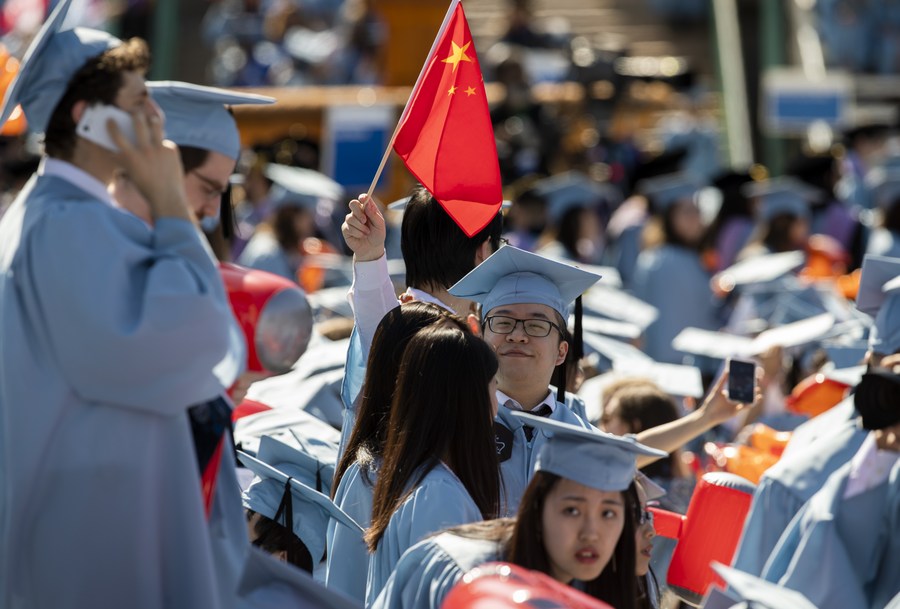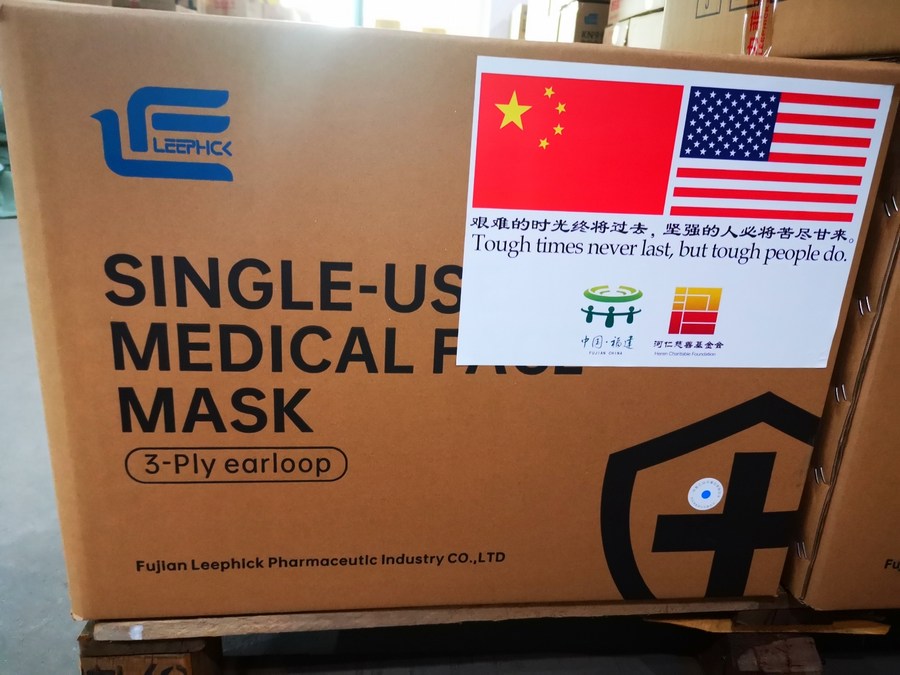
Two girls show their paintings of panda with Chinese traditional painting artist Zhang Liping (C) during the event "From China to Chicago: A Holiday Gathering & Celebration" in Chicago, the United States, on Dec.14, 2019. (Xinhua/Wang Ping)
Mountains do not meet, but people do.
The two peoples' bonds can consolidate the foundation of bilateral ties and mitigate the risk of confrontation in adverse times. They definitely deserve to be enhanced for the benefits of the two peoples and countries.
by Xinhua writer Zhang Xin
BEIJING, Feb. 4 (Xinhua) -- Since Beijing and Washington established diplomatic ties 42 years ago, people-to-people exchanges between the two sides have worked as a bridge and lubricant key to the improvement of the bilateral relations.
Such exchanges, once supported by the leadership of both sides, have thrived in various fields with fruitful results. Yet regrettably, the previous U.S. administration launched a China-bashing campaign in the past four years, casting a chill over those building the bridge from both ends.
The fact that such bonds have withstood the headwinds should not be taken for granted. Beijing has expressed its readiness to restore normalcy to the bilateral relations, while for the U.S. administration taking office two weeks ago, fostering the bonds will help it better get along with China.

Musicians from the Philadelphia Orchestra and Shanghai Philharmonic Orchestra perform during their Chinese New Year Concert in Philadelphia, the United States, Jan. 29, 2019. (Xinhua/Wang Ying)
When "Ping Pong Diplomacy" thawed China-U.S. relations in the 1970s, the Chinese and American people developed an awareness that the two sides can make way for cooperation thanks to the sports spirit.
After the test of the 2008 financial crisis and the launch of the U.S.-China High-Level Consultation on People-to-People Exchange (CPE) in 2010, the people-to-people bonds between the two sides, together with political mutual trust and business ties, formed the three major pillars of bilateral relations.
Forty-two years on, such exchanges in areas of education, science and technology, culture, sports, women, youth and health have helped both sides better understand each other, gluing them together tighter and tighter.
America itself has been a big beneficiary of those exchanges. As individual visits between the two countries increased from only thousands in the 1970s to over 5.3 million in 2017, many U.S. companies, such as Procter & Gamble, Corning glass and General Motors, recorded their biggest boom in China.
During the prime time, more than 400,000 Chinese students studied in the United States and about 20,000 U.S. students in China.
According to U.S. statistics, Chinese students studying in America during 2018-2019 accounted for about a third of international students, contributing about 15 billion U.S. dollars to America in a year.

Graduate students from China attend the Columbia University Commencement ceremony in New York, the United States, May 22, 2019. (Xinhua/Wang Ying)
The reciprocal exchanges encountered "cold spells" as the last U.S. administration moved to restrict Chinese journalists, suspend Chinese students' visas, shut down Confucius Institutes and suppress Chinese companies.
The acts of sabotage by some China hawks disrupted normal bilateral interactions, instigated hatred among the public, and undermined the all-round relations.
Those ill-willed acts were so unpopular that 100 U.S.-based experts, including Ezra Feivel Vogel, the late professor emeritus at Harvard University, wrote to then U.S. President Donald Trump in 2019, stressing that "China is not an enemy."
People-to-people exchanges between China and the United States are indispensable not only because the two sides are so interdependent but also because the world calls for diversity and cooperation instead of isolation and confrontation.
This is why despite the onslaught of COVID-19 and Washington's relentless blows to China-U.S. relations, the Chinese and American people are reaching out to each other.
Local governments, businesses, civil groups and individuals in the United States rendered their support to China's anti-pandemic fight and likewise, many cities, companies, institutions and ordinary people in China stood out to facilitate U.S. purchases of Chinese medical supplies.

Photo taken on April 27, 2020 shows boxes containing face masks donated by China's Fujian Province in Oregon, the United States. (Xinhua)
Mountains do not meet, but people do. "A review of history and reality points to one thing: cooperation between China and the United States is desired by the people in both countries, and such trend cannot be reversed," senior Chinese diplomat Yang Jiechi said in an online conversation with board members of the National Committee on U.S.-China Relations.
About six years ago, when welcoming a Chinese delegation in Washington for the sixth U.S.-China CPE, Joe Biden, then U.S. vice president, said "the (people-to-people) exchange has led to concrete progress in our relationship."
Now, as one of the most important bilateral relations in the world stands at a crossroads, removing the blocks to people-to-people exchanges can be a good start for the Biden administration.
The two peoples' bonds can consolidate the foundation of bilateral ties and mitigate the risk of confrontation in adverse times. They definitely deserve to be enhanced for the benefits of the two peoples and countries. ■




